
Shinobi (忍) is a side-scrolling hack and slash video game produced by Sega, originally released for arcades on the Sega System 16 board in 1987. The player controls ninja Joe Musashi, to stop the Zeed terrorist organization from kidnapping students of his clan.
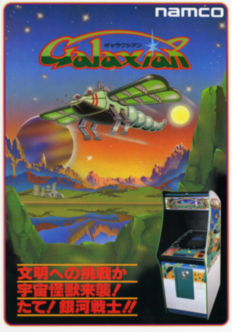
Galaxian is a 1979 fixed shooter arcade video game developed and published by Namco. The player assumes control of the Galaxip starfighter in its mission to protect Earth from waves of aliens. Gameplay involves destroying each formation of aliens, who dive down towards the player in an attempt to hit them.

Track & Field, also known as Hyper Olympic in Japan and Europe, is an Olympic-themed sports video game developed by Konami and released as an arcade video game in 1983. The Japanese release sported an official license for the 1984 Summer Olympics. In Europe, the game was initially released under the Japanese title Hyper Olympic in 1983, before re-releasing under the US title Track & Field in early 1984.

Ikari Warriors, known as Ikari in Japan, is a vertically scrolling run and gun video game released for arcades by SNK in 1986. It was published in North America by Tradewest. At the time there were many Commando clones on the market. What distinguished Ikari Warriors were rotary joysticks and a two-player cooperative mode. The rotary joystick controls were in turn based on SNK's earlier TNK III (1985). Ikari was originally intended to be an official licensed adaptation of the film Rambo: First Blood Part II (1985), but SNK were initially unable to acquire the rights to the film.
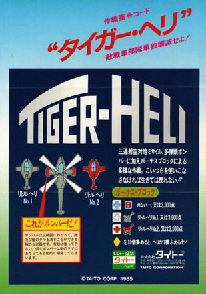
Tiger-Heli is a vertically scrolling shooter game developed by Toaplan and released for arcades in 1985. It was published in Japan by Taito and in North America by Romstar. Controlling the titular attack helicopter, the player must fight endless waves of military vehicles while avoiding collision with their projectiles and other obstacles. The Tiger-Heli has a powerful bomb at its disposal that can clear the screen of enemies when fired. It was the first shoot 'em up game from Toaplan, and their third video game overall.
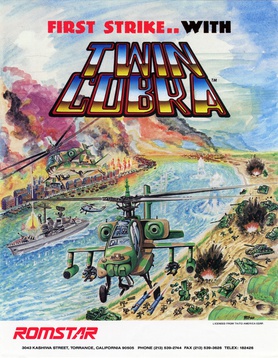
Twin Cobra, known as Kyukyoku Tiger in Japan, is a vertically scrolling shooter developed by Toaplan and released for arcades in 1987 by Taito in Japan and Europe, then in North America by Romstar. It is a sequel to the 1985 arcade game Tiger-Heli. Controlling the titular attack helicopter, the players must fight endless waves of military vehicles while avoiding collision with their projectiles and other obstacles. It was the fourth shoot 'em up game from Toaplan, and their tenth video game overall. It was ported to multiple platforms, with each done by different third-party developers that made several changes or additions.
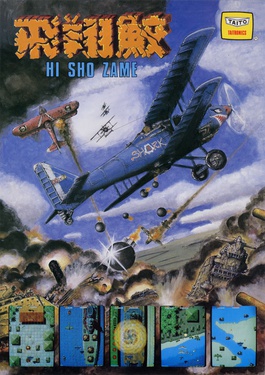
Flying Shark, known as Sky Shark in North America, is a vertically scrolling shooter arcade video game originally developed by Toaplan and published in 1987 by Taito in Japan, Romstar in North America and Electrocoin in Europe. Controlling the titular biplane, the players must fight endless waves of military vehicles while avoiding collision with their projectiles and other obstacles. The plane has a powerful bomb at its disposal that can clear a portion of the screen of bullets and damage enemies when fired. It was the third shoot 'em up game from Toaplan, and their eighth video game overall.

Choplifter is a military themed scrolling shooter developed by Dan Gorlin for the Apple II and published by Broderbund in 1982. It was ported to Atari 8-bit computers the same year and also to the VIC-20, Commodore 64, Atari 5200, ColecoVision, MSX, and Thomson computers.

Elevator Action is a platform shooter game released in arcades by Taito in 1983. The player assumes the role of Agent 17, a spy infiltrating a 30-story building filled with elevators and enemy agents who emerge from closed doors. The goal is to collect secret documents from specially marked rooms, then escape the building. It runs on the Taito SJ System arcade system.

Star Wars is a first-person rail shooter designed by Mike Hally and released as an arcade video game in 1983 by Atari, Inc. It uses 3D color vector graphics to simulate the assault on the Death Star from the 1977 film Star Wars. There are three connected gameplay sequences: combat against TIE fighters in space, flying across the surface of the Death Star, and the final trench run. The sequence repeats with added complications and the Death Star regenerating for each. The player's X-Wing fighter has a shield which only protects against damage a certain number of times, then the next hit ends the game. Speech synthesis emulates actors from the film.

Operation Wolf is a light gun shooter arcade game developed by Taito and released in 1987. It was ported to many home systems.
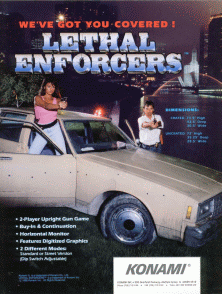
Lethal Enforcers is a 1992 light gun shooter released as an arcade video game by Konami. The graphics consist entirely of digitized photographs and digitized sprites. Home versions were released for the Super NES, Genesis and Sega CD during the following year and include a revolver-shaped light gun known as The Justifier.

Jackal, also distributed under the title of Top Gunner, is an overhead run and gun video game released for arcades by Konami in 1986. The player must maneuver an armed jeep in order to rescue prisoners of war (POWs) trapped in enemy territory.

Guerrilla War, released in Japan as Guevara (ゲバラ), is an overhead run and gun video game developed and published by SNK. Originally released in 1987 as a coin-operated arcade video game, Guerrilla War was ported to the Amstrad CPC, Apple II, Commodore 64, MS-DOS, Nintendo Entertainment System, PlayStation Network, and ZX Spectrum.
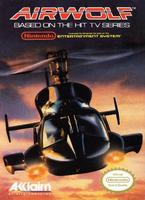
Airwolf is a series of shooter video games based on the TV series of the same name. The first game based on the series was released for the ZX Spectrum by Elite Systems in 1984. The game also was released on the Commodore 64, Amstrad CPC, and Atari 8-bit computers. A sequel, Airwolf II, was released in 1986.

Galaga '88 is a 1987 fixed shooter arcade video game developed and published in Japan by Namco and in North America and Europe by Atari Games. It is the third sequel to Galaxian. It features significantly improved graphics over the previous games in the series, including detailed backgrounds, larger enemies and greater ship details. The game runs on Namco System 1 hardware.

Twin Cobra II is a vertically scrolling shooter arcade video game developed by Takumi Corporation and published in 1995 by Taito in Japan, Asia and Europe. It is the sequel to Twin Cobra from 1987. Taking place after the events of the previous game, players assume the role of two pilots taking control of their respective attack helicopters to overthrow the returning enemy forces.
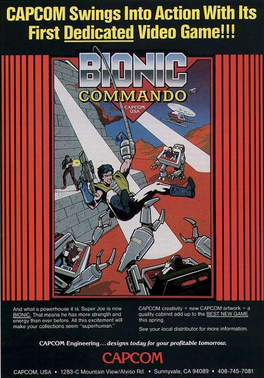
Bionic Commando, released in Japan as Top Secret is a run and gun platform game released by Capcom in arcades in 1987. It was designed by Tokuro Fujiwara as a successor to his earlier "wire action" platformer Roc'n Rope (1983), building on its grappling hook mechanic; he was also the designer of Commando (1985). The music was composed by Harumi Fujita for the Yamaha YM2151 sound chip.

Cobra Command (コブラコマンド) is a horizontally scrolling shooter released as an arcade video game by Data East in 1988. A port was published for the Nintendo Entertainment System later the same year.
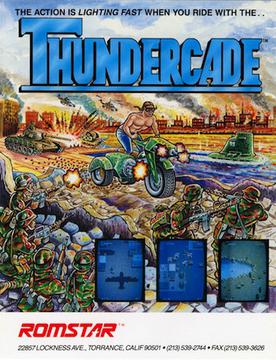
Thundercade, also known as Twin Formation and 特殊部隊UAG", is a vertically scrolling shooter developed by SETA and released as an arcade game in 1987. A version for the Nintendo Entertainment System from American Sammy was released in 1989.




















